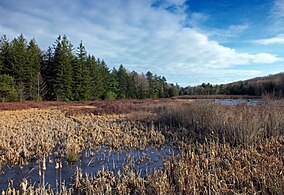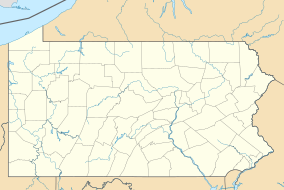
Back Black Moshannon State Park CEB Parque estatal Black Moshannon Spanish Parc d'État de Black Moshannon French Park stanowy Black Moshannon Polish
| Black Moshannon State Park | |
|---|---|
 View of bog and lake from the bog trail in the Black Moshannon Bog Natural Area at Black Moshannon State Park | |
| Location | Rush, Centre, Pennsylvania, United States |
| Coordinates | 40°53′54″N 78°03′23″W / 40.89833°N 78.05639°W[1][2] |
| Area | 3,480 acres (14.1 km2)[3] |
| Elevation | 1,919 ft (585 m)[1] |
| Established | 1937[4][5] |
| Named for | Black Moshannon Creek |
| Visitors | 316,000 (in 2019)[6] |
| Governing body | Pennsylvania Department of Conservation and Natural Resources |
| Website | Black Moshannon State Park |
Black Moshannon State Park is a 3,480-acre (1,410 ha) Pennsylvania state park in Rush Township, Centre County, Pennsylvania, United States. It surrounds Black Moshannon Lake, formed by a dam on Black Moshannon Creek, which has given its name to the lake and park. The park is just west of the Allegheny Front, 9 miles (14 km) east of Philipsburg on Pennsylvania Route 504, and is largely surrounded by Moshannon State Forest. A bog in the park provides a habitat for diverse wildlife not common in other areas of the state, such as carnivorous plants, orchids, and species normally found farther north. As home to the "largest reconstituted bog in Pennsylvania", it was chosen by the Pennsylvania Department of Conservation and Natural Resources for its "25 Must-see Pennsylvania State Parks" list.[7]
Humans have long used the Black Moshannon area for recreational, industrial, and subsistence purposes. The Seneca tribe used it as hunting and fishing grounds. European settlers cleared some land for farming, then clear-cut the vast stands of old-growth white pine and eastern hemlock. Black Moshannon State Park rose from the ashes of a depleted forest which had been largely destroyed by wildfire in the years following the lumber era. The forests were rehabilitated by the Civilian Conservation Corps during the Great Depression in the 1930s. Many of the buildings built by the Civilian Conservation Corps stand in the park today and are protected on the list of National Register of Historic Places in three historic districts.
Black Moshannon State Park is open year-round for recreation and has an extensive network of trails which allow hiking, biking, and viewing the bog habitat at the Black Moshannon State Natural Area. The park is in a Pennsylvania Important Bird Area, where bird watchers have recorded 175 species. It is also home to many rare and unusual plants and animals due to its location atop the Allegheny Plateau; the lake is at an elevation of about 1,900 feet (580 m). Much of the park is open for hunting and the lake and creek are open for fishing, boating, and swimming. In winter it is a popular destination for cross-country skiing, and was home to a small downhill skiing area from 1965 to 1982. Picnics and camping are also popular, and the "Friends of Black Moshannon State Park" group promotes the park and all the recreational activities associated with it.
- ^ a b Cite error: The named reference
gniswas invoked but never defined (see the help page). - ^ Cite error: The named reference
penndotwas invoked but never defined (see the help page). - ^ "The Pennsylvania Manual, Volume 123, Appendix 9-11" (PDF). State of Pennsylvania. 2017. Archived (PDF) from the original on July 28, 2019. Retrieved June 24, 2020. Note: The Pennsylvania Manual area is slightly larger than the value on the park's website of 3,394 acres (1,374 ha).
- ^ "Black Moshannon State Park: History". Pennsylvania Department of Conservation and Natural Resources. Archived from the original on July 3, 2017. Retrieved June 24, 2020.
- ^ Cite error: The named reference
cabinswas invoked but never defined (see the help page). - ^ "DCNR Names New Manager at Black Moshannon State Park". Pennsylvania Department of Conservation and Natural Resources. January 24, 2020. Retrieved June 25, 2020.
- ^ "25 Must-see Pennsylvania State Parks". Pennsylvania Department of Conservation and Natural Resources. Archived from the original on May 17, 2018. Retrieved June 24, 2020.

